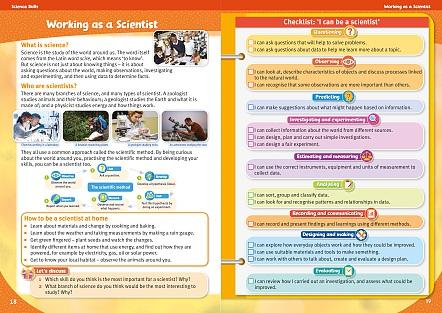
2 minute read
The Air We Breathe Living things; Materials; Environmental awareness and care Human life; Properties and the characteristics of materials; Science and the environment
from Explore with Me 6
by Edco Ireland
Types of TerrainAroundtheWorld
Interactiveactivity The Antarctic consists of Antarctica, the Southern Ocean and a number of uninhabited islands. It is the coldest place on Earth. Temperatures here usually range from –28°C in summer to –60°C in winter, but the lowest temperature ever recorded was –89.2°C. The highest peak is Mount Vinson, at 4,892 metres. There are a number of massive ice shelves connected to the coastline of Antarctica. These are permanent sheets of ice that extend out onto the ocean. The largest is the Ross Ice Shelf, which has an area of 510,680 km2 .
17
Ross IceShelf Digital resources: Bonus content and interactive activities available via the e-book on the Edco Learning website
Reference zone
● ‘I can…’ checklists: Tick off your new skills as they develop. ● Let’s discuss: Start a conversation by using these questions. ● Timeline: Compare when different events covered in the book took place. ● Maps: Practise your map skills with our world, Europe, Greece, Ireland and South
America maps. ● Glossary: Look up the meaning of new words in the illustrated glossary at the back of the book.


Show what you know: Seven questions to show what you have learnt in the chapter The importance of the polar regions Roughly 2% of the Earth’s water (which is almost 70% of Earth’s freshwater) is stored in glaciers and ice caps in the polar regions. The ice helps to regulate the Earth’s temperatures by reflecting 70% of the sun’s energy in these regions. It is estimated that the Arctic ice is melting at a rate of 9% per decade. This could contribute to warmer global temperatures due to less reflection of the sun’s energy. Since the 1970s, the amount of krill in the Arctic Ocean has been decreasing.This is thought to be linked to the melting of the ice. Marine animals rely on krill as a food source, so this is affecting the food chain. The ice in the Arctic is also a habitat for seals and polar bears. As it melts, their habitat shrinks. 1 2 3 4 5 6 7 Name the seven continents. What is a mountain ridge? Where are the Himalayas situated? How big is the Sahara Desert? Where are the polar regions? Describe the landscape and temperatures there. Why, do you think, do very few people in Australia live in the Outback? Explain what is important about the polar regions. 1 Label all of the features discussed in the chapter on your worksheet. 2 Think, pair, share: Write three features or characteristics of each of the following: mountain ranges, deserts and polar regions. 3 Group work: Research ideas about how to prevent the polar ice cap in the Arctic from melting. Present your findings to the class as a poster, slideshow or multimedia presentation. PCM 11 99



PCM: Shows your teacher there is a photocopiable worksheet for this chapterLet’s get exploring: Three exciting activities to do on your own, with a partner and as a group ©The Educational Company of Ireland
9











